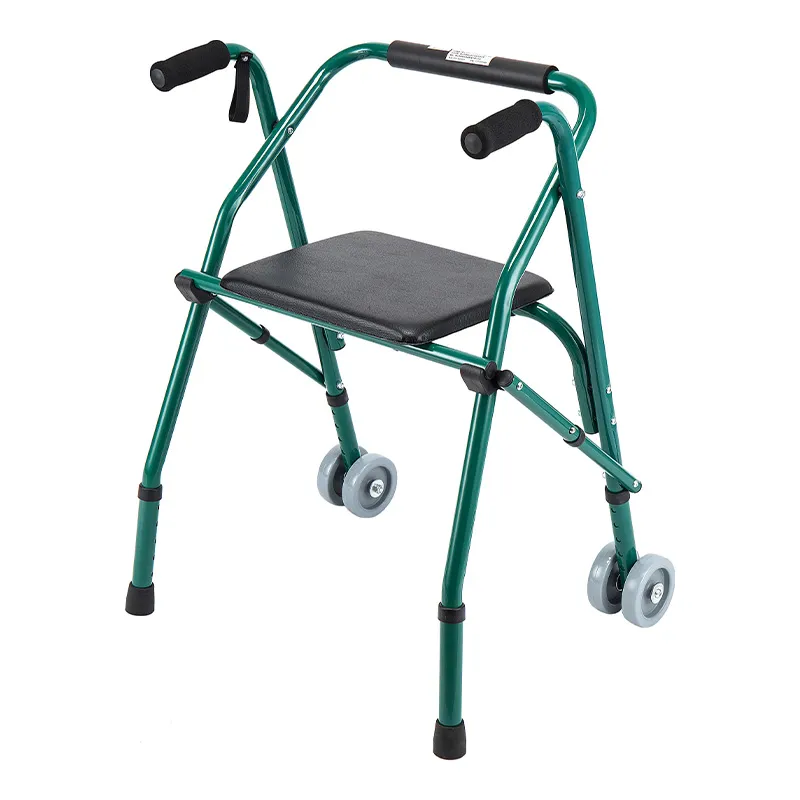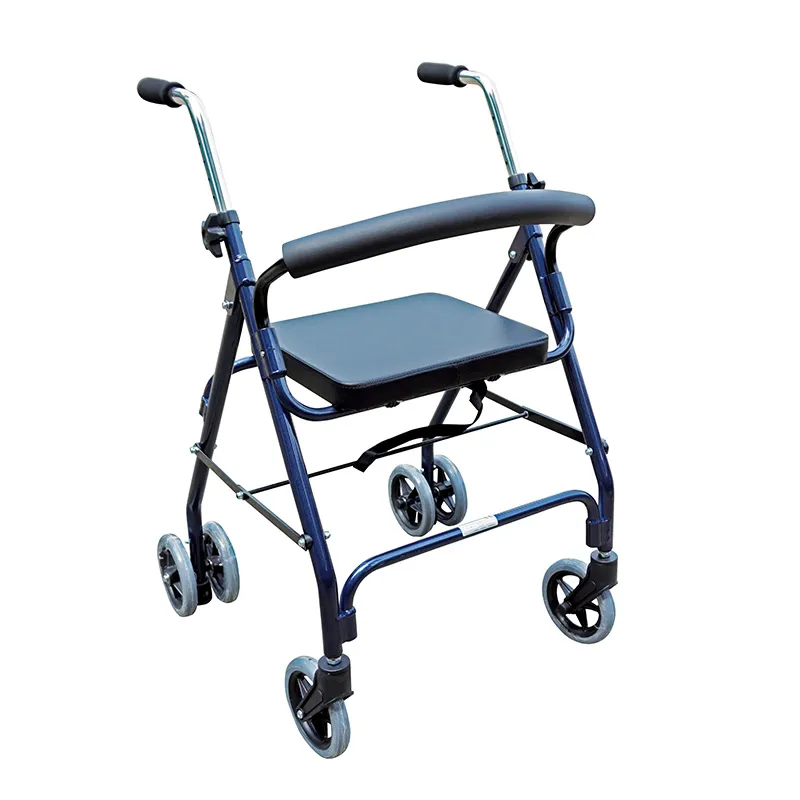
How to choose a good walker?
2024-09-04 15:30
As an important walking aid, walkers are widely used in the daily lives of the elderly and people with limited mobility. Choosing a suitable walker can not only improve the quality of life of users, but also enhance their walking safety.
So, how to choose a good walker? What factors should be considered when buying a walker? This article will analyze this issue in depth and provide readers with a detailed guide.

What should be considered when buying a walker?
Ⅰ. Understand the basic types of walkers
Before choosing a walker, you first need to understand the different types of walkers on the market. Common walkers mainly include the following:
1. Standard walker: wheelless design, users need to lift the walker to move, suitable for users who need high stability.
2. Wheeled walker: front wheel or four-wheel design, easy to move, suitable for users with moderate to severe walking difficulties.
3. Rollator: equipped with four wheels, brake system and seat, suitable for users who walk long distances and outdoor activities.
Ⅱ. Factors to consider when choosing a walker
After understanding the basic types, there are several key factors to consider when choosing a walker:
Wheel size:
The wheel size of a walker is one of the important factors that affect its use experience. Generally speaking, the wheel size of a walker ranges from 4 inches to 10 inches.
● Small wheels (4-6 inches): suitable for indoor use, flexible turning, and suitable for narrow spaces.
● Large wheels (8-10 inches): suitable for outdoor use, and can better cope with uneven ground, such as grass, gravel roads, etc.
Height adjustment:
The height of the walker should be suitable for the user's height to ensure comfort and safety. Most walkers are adjustable in height, and the general adjustment range is between 28 and 38 inches (about 71 to 96 cm). Users can determine the appropriate height according to the following methods:
● Wear shoes for daily walking.
● Stand naturally with your arms hanging down.
● Measure the vertical distance from the ground to the wrist, which is usually the optimal height of the walker handle.
Weight:
The weight of a walker directly affects its portability and ease of use. Generally speaking, the weight of a walker ranges from 5 to 10 pounds (about 2.3 to 4.5 kilograms).
● Lightweight walkers: weighing between 5 and 7 pounds (about 2.3 to 3.2 kilograms), suitable for users who need to carry and move frequently.
● Heavier walkers: weighing between 8 and 10 pounds (about 3.6 to 4.5 kilograms), suitable for users who need more stability and support.
Foldable design:
For users who need to go out frequently or have limited storage space, the foldable design of the walker is an important consideration. Foldable walkers are easy to carry and store, and they only need to be unfolded when used.
● Portability: Foldable walkers are easy to put in the trunk of a car or take on public transportation.
● Convenient storage: Foldable walkers can save storage space when not in use.
Additional functions:
Some walkers are equipped with additional functions and accessories to improve the convenience and comfort of use.
● Seat and backrest: Some wheeled walkers are equipped with seats and backrests, which are convenient for users to rest during walking.
● Storage basket or bag: Convenient for carrying personal items such as water bottles, medicines, mobile phones, etc.
● Brake system: Rollator is usually equipped with a brake system, which increases the safety of walking.

III. The use environment of the walker
When choosing a walker, you also need to consider the use environment. This determines the type of walker and the specific functional requirements.
Indoor use:
If the walker is mainly used indoors, it is more appropriate to choose a walker that is lightweight and flexible in turning.
● Wheelless or small-wheeled walkers: Suitable for use in narrow spaces, such as home corridors, rooms, etc.
● Silent design: Some walkers are designed with silent foot pads or wheels to reduce noise when used indoors.
Outdoor use:
If the walker is mainly used outdoors, you need to choose a walker suitable for uneven ground.
● Large-wheeled walkers: suitable for uneven surfaces such as grass and gravel roads.
● Rollator: equipped with four wheels and a brake system, suitable for long-distance walking and outdoor activities.
IV. Personal health status and needs
The choice of a walker should also be personalized according to the user's specific health status and needs.
Walking ability:
Assess the user's walking ability to choose the right type of walker.
● Mild walking difficulty: wheelless walkers or small-wheeled walkers provide adequate support and stability.
● Moderate to severe walking difficulty: wheeled walkers or Rollator provide better mobility and support.
Weight and body shape:
The user's weight and body shape are also important factors in choosing a walker. Make sure the walker can provide adequate support and comfort.
● Heavier weight: Choose a steel walker, which provides higher support and stability.
● Smaller body shape: Choose a lightweight walker for easy control and use.

Ⅴ. Brand and quality of walkers
When choosing a walker, brand and quality are factors that cannot be ignored. Well-known brands usually provide better product quality and after-sales service.
Brand reputation:
Choosing a walker from a well-known brand can ensure the quality and safety of the product.
● Well-known brands: Such as Drive Medical, Medline, Invacare, etc., are all brands with good reputation in the market.
● User reviews: By checking user reviews, you can understand the actual use effect and reliability of the product.
Quality assurance:
High-quality walkers can not only provide a better use experience, but also ensure durability for long-term use.
● Material selection: High-quality aluminum alloy or steel can provide better durability and safety.
● Craftsmanship quality: Ensure that the connecting parts of the walker are firm, the design is reasonable, and it is safe to use.
Ⅵ. Trial and purchase of walkers
Before deciding to buy a walker, it is best to try it out to ensure that it suits your needs.
Trial experience:
When trying a walker, pay attention to the following points:
● Comfort: Is it comfortable to hold the handle and is the height of the walker appropriate?
● Stability: Is the walker stable during use and does it provide sufficient support?
● Portability: Is the folding and unfolding of the walker convenient and is the weight appropriate?
Purchase channel:
Choosing a formal channel to purchase a walker can ensure the quality and after-sales service of the product.
● Medical device store: Provide professional advice and after-sales service.
● Online shopping mall: Such as Amazon, JD.com, etc., provide a variety of brands and models to choose from.

Summary of choosing a suitable walker
Choosing a suitable walker requires comprehensive consideration of multiple factors: wheel size (4 inches to 10 inches), height adjustment (28 to 38 inches), weight (5 to 10 pounds), foldable design, additional functions (seat and backrest), use environment, personal health status and needs, brand and quality, etc.
When actually selecting and using a walker, it is recommended that the user do so under the guidance of a professional to ensure that the selected walker can best meet personal needs and provide the best quality walking assistance and support.








